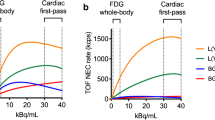Abstract
This study investigated whether reperfusion results in an increase of ultrastructurally determined myocardial injury in pig hearts. The left anterior descending coronary artery (LAD) was distally occluded in 12 pigs for 35–45 minutes and then reperfused for 3 hours. At the end of ischemia, as well as after 3 hours of reperfusion, one transmural biopsy was removed from the center of the risk region and subdivided into four specimens, representing the subendocardial (I), subendo-midmyocardial (II), subepi-midmyocardial (III), and subepicardial layers (IV). The degree of injury was assessed by electronmicroscopy and was scored as reversible (1), an almost equal mixture of reversible and irreversible (2), and totally irreversible (3) damage. In addition, infarct size was determined as the ratio of infarcted (tetrazolium stain) to ischemic (dye technique) myocardium. Infarct sizes ranged from 29.3% to 93% (mean 61.2%). The scores of injury of the four tissue layers before and after reperfusion did not differ significantly: layer I, 2.4 ± 0.8/2.3 ± 0.9; layer II, 2.2 ± 0.9/2.0 ± 0.9; layer III, 1.8 ± 0.9/2.0 ± 0.9; and layer IV, 1.6 ± 0.9/1.3 ± 0.6. The means of the four layers were almost identical at the end of ischemia (2.1 ± 0.8) and after 3 hours of reperfusion (2.0 ± 0.6). A linear regression analysis with 95% confidence limits of the score values before and after reperfusion indicated that maximally 25% of a mean final infarct size of about 50% may be due to lethal reperfusion injury. This study suggests that cell death in regional ischemia and reperfusion occurs predominantly during ischemia and not during reperfusion.
Similar content being viewed by others
References
Ambrosio G, Becker LC, Hutchins GM, Weisman HF, Weisfeld ML. Reduction in experimental infarct size by recombinant human superoxide dismutase: Insight into the pathophysiology of reperfusion injury. Circulation 1986;74:1424–1433.
Forman MB, Velasco CE, Jackson E: Adenosine attenuates reperfusion injury following regional myocardial ischemia. Cardiovasc Res 1993;27:9–17.
Klein HH, Pich S, Lindert S, Nebendahl K, Warneke G, Kreuzer H. Treatment of reperfusion injury with intracoronary calcium channel antagonists and reduced coronary free calcium concentration in regionally ischemic, reperfused porcine hearts. J Am Coll Cardiol 1989;13:1395–1401.
Garcia-Dorado D, Theroux P, Duran JM, et al. Selective inhibition of the contractile apparatus, a new approach to modification of infarct size, infarct composition, and infarct geometry during coronary artery occlusion and reperfusion. Circulation 1992;85:1160–1174.
Opie LH. Reperfusion injury and its pharmacologic modification. Circulation 1989;80:1049–1062.
Kloner RA. Does reperfusion injury exist in humans? J Am Coll Cardiol 1993;21:537–545.
Hearse DJ. Myocardial injury during ischemia and reperfusion. In: Yellon DM, Jennings RB, eds. Myocardial Protection. The Pathophysiology of Reperfusion and Reperfusion Injury. New York: Raven Press, 1992:13–33.
Ganz W, Watanabe I, Kanamasa K, Yano J, Han D-S, Fishbein MC. Does reperfusion extend necrosis? A study in a single territory of myocardial ischemia—half reperfused and half not reperfused. Circulation 1990;82:1020–1033.
Reimer KA, Jennings RB. Can we really quantitate myocardial cell injury. In: Hearse DJ, Yellon DM, eds. Therapeutic Approaches To Myocardial Infarct Size Limitation. New York: Raven Press, 1984:163–184.
Klein HH, Pich S, Lindert S, Buchwald A, Nebendahl K, Kreuzer H. Intracoronary superoxide dismutase for the treatment of “reperfusion injury.” A blind randomized placebo-controlled trial in ischemic, reperfused porcine hearts. Basic Res Cardiol 1988;83:141–148.
Baller ID, Bretschneider HJ, Hellige G. Validity of myocardial oxygen consumption parameters. Clin Cardiol 1979;2:317–327.
Jennings RB, Baum JH, Herdson PB: Fine structural changes in myocardial ischemic injury. Arch Pathol 1965;79:135–143.
Schaper J, Mulch B, Winkler B, Schaper W. Ultrastructural, functional, and biochemical criteria for estimation of reversibility of ischemic injury: A study on the effects of global ischemia on the isolated dog heart. J Mol Cell Cardiol 1979;11:521–541.
Schaper J. Ultrastructural changes of the myocardium in regional ischaemia and infarction. Eur Heart J 1986;7(Suppl B):3–9.
Klein HH, Puschmann S, Schaper J, Schaper W. The mechanism of the tetrazolium reaction in identifying experimental myocardial infarction. Virchows Arch (Pathol Anat) 1981;393:287–297.
Bohle RM, Klein HH, Pich S, Lindert-Heimberg S, Gehrke D, Nebendahl K. Interstitial myocardial neutrophil accumulation between 3 and 72 h or reperfusion does not significantly affect infarct size in porcine hearts. Am J Cardiovasc Pathol 1993;4:336–342.
Miyazaki S, Fujiwara H, Onodera T, et al. Quantitative analysis of contraction band and coagulation necrosis after ischemia and reperfusion in the porcine heart. Circulation 1987;75:1074–1082.
Reimer KA, Jennings RB. The “wavefront phenomenon” of myocardial ischemic cell death. II. Transmural progression of necrosis within the frame work of ischemic bed size (myocardium at risk) and collateral blood flow. Lab Invest 1979;40:633–644.
Eckstein RW. Coronary interarterial anastomoses in young pigs and mongrel dogs. Circ Res 1954;2:460–465.
Sjöquist P-D, Duker G, Almgren D. Distribution of the collateral blood flow at the lateral border of the ischemic myocardium after acute coronary occlusion in the pig and the dog. Basic Res Cardiol 1984;79:164–175.
Fujiwara H, Ashraf S, Sato S, Millard R. Transmural cellular damage and blood flow distribution in early ischemia in pig hearts. Circ Res 1982;51:683–693.
Taylor IM, Shaikh NA, Downar E. Ultrastructural changes of ischemic injury due to coronary artery occlusion in the porcine heart. J Mol Cell Cardiol 1984;16:79–94.
Pich S, Klein HH, Lindert S, Nebendahl K, Kreuzer H: Cell death in ischemic, reperfused porcine hearts: A histochemical and functional study. Basic Res Cardiol 1988;83:550–559.
Author information
Authors and Affiliations
Rights and permissions
About this article
Cite this article
Klein, H.H., Pich, S., Lindert-Heimberg, S. et al. Ultrastructural evaluation of postischemic cell death (lethal reperfusion injury) in porcine hearts. J Thromb Thrombol 3, 361–366 (1996). https://doi.org/10.1007/BF00133079
Received:
Accepted:
Issue Date:
DOI: https://doi.org/10.1007/BF00133079




